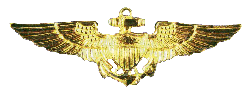
Cecil E. Harris
![]()

Like Joe Foss, here was another Pacific ace from the inland state of South Dakota. Born in 1916, he was attending Northern State Teachers' College when WWII started. He joined the Navy before Pearl Harbor, and was appointed an aviation cadet. He trained at Minneapolis and Corpus Christi, and in April 1942 became part of VMF-27, and received more training. He took part in the Operation Torch landings in North Africa. In 1943, he served in Guadalcanal, shooting down two Japanese planes. Harris shot down enemy planes in bunches: four on three occasions, and twice downing three. He earned the Navy Cross, the DFC, a Silver Star, and two Gold Stars.
At age 29, relatively old, by WWII fighter pilot standards, Cecil Harris flew F6F Hellcats for VF-18, based on the carrier USS Intrepid. On October 12, 1944, he embarked on a memorable mission, an air strike at Jap airfields on Formosa, in preparation for the assault on the Philippines. October 12 was the first of three days of strikes against the significant land-based air forces that the Japanese had at Formosa. VF-18 was flying cover for the torpedo squadron, VT 18, and the dive-bombing squadron, VB 18. Harris was one of 16 pilots from VF-18 participating in the day's fighter sweep, launched before dawn in order to catch the enemy aircraft on the ground at dawn. This was the first fighter sweep of the war to be launched against Formosa.
VF-18 was to fly northwest from the Intrepid, to hit an airfield on the northeastern corner of Formosa, as outlined by the squadron leader, Lt. Cdr. Ed Murphy. On schedule, all the Hellcats were catapulted off the carrier, and began their slow climb to altitude. Murphy's own division of four planes was in the lead, the second division behind and to the right. Behind the second division, and well to the left was Harris' third division. The fourth division behind and to the left of Harris; all climbing at 150 knots. Many planes from other Task Force 38 carriers accompanied VF-18. All maintained radio silence, as they leveled off at 15,000 feet.
As they approached Formosa, they pointed their noses downward and began to gain speed. As Harris, his wingman Burley, and Lt. Bill Zeimer's section approached the field, five enemy bombers had just taken off from the field. In a few seconds Zeimer's gunfire tore into and exploded the first bomber. Harris soon added one of his own. They turned and both quickly splashed another bomber each. Easy so far, but Zeroes appeared up above, dove down and shot up Zeimer's plane. A chute opened up and Zeimer floated out. His wingman, DiBatista, locked onto the Zero and avenged Zeimer's loss. Another Zero dived onto DiBatista, and hit him with 20mm cannon fire. But Harris' concentrated 50 caliber fire has taken a heavier toll, and the Harris gained his third victory of the day.
While escorting the DiBatista's damaged plane back to the Intrepid, he downed another Zero, his fourth of the day. Harris had three "4-kill" days, while accumulating a total of 24 victories against the Japanese (the second highest scoring US Navy ace). He was out of action from November, 1944, when the Intrepid was badly damaged in a kamikaze attack.
Hall of Fame WWII | Aircraft Selection | Feedback | Home